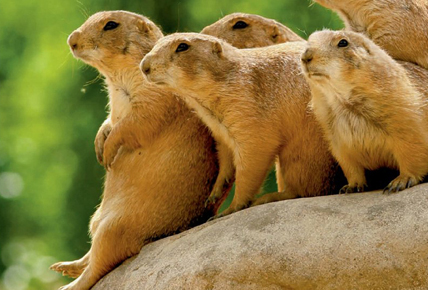Parts: One — Two — Three — Four — Five — Six — Seven — Eight
I did stand under the streetlight on that lonely highway, right enough. After hours of waiting, I began to study the darkness around me, projecting my fears into it, and as I began to think more and more of things that might lurk out there, I gradually froze into spooked immobility. Though I never saw or heard the merest evidence that anything was out there, I stood locked in place, imagining everything from my rocketing, deadly Face Eater to a pack of rabid wolves, from the eighteen foot tall mutant killer bear I’d see in a movie to a horde of screaming, red-eyed baboons, escaped from some cheap carnival and out for blood.
Locked into the recursive reverberation of my own imaginings, I scared myself at nothing. I allowed florid, fictional images to fill my mind and echo back and forth, growing until I could no longer even think.
Betting Against the Grizzly
Thanks to movie-makers, hunting magazines, and purveyors of other kinds of pop entertainment, whenever we hear talk comparing Man the Animal with other creatures, poor Man usually comes out a weak and fragile nebbish, stuck out in the dangerous wilds, scared and alone. He sits down at Nature’s card game with his measly pair of Jacks (his intelligence), and a host of massive, befanged predators snicker at him over paws full of aces: claws, razor teeth, rocketing speed, eagle eyes, merciless instincts wired to unpredictable rage and a hunger for flesh.
The lurid cover story in a hunting magazine stacks the defenseless little Man against a grizzly. The friendly, harmless human – it might be your own uncle, out for a walk – is introduced in folksy language. Soon the deadly griz enters the tale, big as a Sherman tank and mean as a biker on angel dust. Weights are compared. Strength is described. The number and size of teeth come into the story, and the length of claws.
The fear builds. The hapless human is just out for a little harmless recreation, but the deadly dangerous, unbeatable monster of a grizzly has every murderous intention of stalking, horribly killing, and slowly, over a number of days, consuming the bloody carcass of the poor little Man.
And there’s no doubt it has happened. Wild animals don’t keep records, but humans certainly do. Wikipedia’s entry on bear attacks lists close to 60 fatal attacks by brown bears in the U.S. since the 1870s, with an additional 53 by black bears and seven more by polar bears. (Scarily personal, the list includes someone I actually knew: Tim Treadwell.)
A comparison of griz and man certainly is eyebrow-raising. Though continental grizzlies come in at an already-impressive 900 pounds or so, the tabloid-fodder Alaskan brown bear, Ursus arctos middendorffi, might tip the scales at 1500 pounds and be nine feet long. It can run at 30 or more miles an hour, propelled across the ground on paws equipped with six inch claws. Its hungry mouth is equipped with fangs inches long.
Compare this to an adult male human, who’d weigh in around 200 pounds. Feeble little fingernails. Flat nubbins of teeth. And not a hope in hell of outrunning this souped-up freight train with fur.
We live today in a pretty safe world. Back in the era of the literally-naked savage, not only did we have nothing in the way of machine-era technology – no weapons that didn’t depend on our own muscle power – but the predators were bigger. Imagine living in North America with the sabertoothed cat and the short-faced bear (think of a grizzly on steroids with some thoroughbred racehorse genes thrown in for speed), or the great variety of predators elsewhere in the world – creatures fiercer, more varied, more numerous, and probably much less afraid of us than anything alive today.
It seems a stroke of wild, improbable luck that we survived to the modern day. What, really, could account for it? Do we have any advantages at all, compared to wild animals? Can we tease out any single trait, other than blind luck, that kept us alive this long?
— CONTINUED —
Parts: One — Two — Three — Four — Five — Six — Seven — Eight









